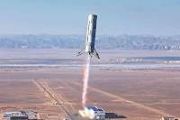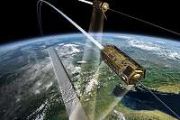
Copernical Team
AST SpaceMobile Prepares to Ship First Five Commercial Satellites
 AST SpaceMobile, Inc. (NASDAQ: ASTS) has announced the completion of its first five commercial satellites, named Bluebirds. These satellites, each equipped with communications arrays spanning 693 square feet, are set to be shipped to Cape Canaveral in the first week of August. A 7-day launch window is scheduled for September.
"This is a momentous occasion for AST SpaceMobile. These first f
AST SpaceMobile, Inc. (NASDAQ: ASTS) has announced the completion of its first five commercial satellites, named Bluebirds. These satellites, each equipped with communications arrays spanning 693 square feet, are set to be shipped to Cape Canaveral in the first week of August. A 7-day launch window is scheduled for September.
"This is a momentous occasion for AST SpaceMobile. These first f China's Climate and Carbon Monitoring Satellites Now Operational
 China's new atmospheric environment monitoring satellite and terrestrial ecosystem carbon monitoring satellite are now officially operational, according to the China National Space Administration (CNSA).
"During their in-orbit testing, these satellites demonstrated favorable application results across multiple areas, including ecological environment, forestry and grassland, geographic surv
China's new atmospheric environment monitoring satellite and terrestrial ecosystem carbon monitoring satellite are now officially operational, according to the China National Space Administration (CNSA).
"During their in-orbit testing, these satellites demonstrated favorable application results across multiple areas, including ecological environment, forestry and grassland, geographic surv Kepler's 1607 Sunspot Sketches Shed Light on Early Solar Cycles
 Researchers have utilized modern techniques to revisit Johannes Kepler's historic sunspot drawings from 1607, uncovering new insights into solar cycles prior to the grand solar minimum. Led by Nagoya University in Japan, the international team reexamined Kepler's observations using Sporer's law and modern statistical methods. They accurately pinpointed the sunspot group's position, identifying i
Researchers have utilized modern techniques to revisit Johannes Kepler's historic sunspot drawings from 1607, uncovering new insights into solar cycles prior to the grand solar minimum. Led by Nagoya University in Japan, the international team reexamined Kepler's observations using Sporer's law and modern statistical methods. They accurately pinpointed the sunspot group's position, identifying i Ariel's Carbon Dioxide Indicates Potential Subsurface Ocean on Uranus' Moon
 The surface of Uranus' moon Ariel contains substantial carbon dioxide ice, particularly on its trailing hemisphere, the side that faces away from its orbital motion. This is unexpected as carbon dioxide, even in the distant Uranian system-20 times farther from the Sun than Earth-easily sublimates into gas and escapes into space.
Researchers propose that the carbon dioxide on Ariel's surfac
The surface of Uranus' moon Ariel contains substantial carbon dioxide ice, particularly on its trailing hemisphere, the side that faces away from its orbital motion. This is unexpected as carbon dioxide, even in the distant Uranian system-20 times farther from the Sun than Earth-easily sublimates into gas and escapes into space.
Researchers propose that the carbon dioxide on Ariel's surfac NASA-Backed Burst Test Advances Orbital Reef Development
 A critical component of the Orbital Reef commercial space station, developed by Blue Origin and Sierra Space with NASA funding, has successfully completed a full-scale burst pressure test. This achievement marks significant progress in NASA's efforts to establish new low Earth orbit destinations.
This milestone comes under a NASA Space Act Agreement awarded to Blue Origin in 2021. The Orbi
A critical component of the Orbital Reef commercial space station, developed by Blue Origin and Sierra Space with NASA funding, has successfully completed a full-scale burst pressure test. This achievement marks significant progress in NASA's efforts to establish new low Earth orbit destinations.
This milestone comes under a NASA Space Act Agreement awarded to Blue Origin in 2021. The Orbi Two Environmental Protection Satellites Begin Operations in China
 China has officially commenced the operation of two advanced environmental protection satellites, as announced by the China National Space Administration (CNSA).
During a handover ceremony at CNSA's headquarters in Beijing, control of the Atmospheric Environmental Surveyor and the Terrestrial Ecosystem Carbon Inventory Satellite was transferred to their designated users. These users includ
China has officially commenced the operation of two advanced environmental protection satellites, as announced by the China National Space Administration (CNSA).
During a handover ceremony at CNSA's headquarters in Beijing, control of the Atmospheric Environmental Surveyor and the Terrestrial Ecosystem Carbon Inventory Satellite was transferred to their designated users. These users includ Scientists Recreate Stellar Reactions in Laboratory
 In space, some stars engage in a process where they draw energy and material from neighboring stars. By studying these interactions, researchers can gain insights into the formation of cosmic elements that are fundamental to planets, particles, and life on Earth.
Researchers at the Department of Energy's (DOE) Oak Ridge National Laboratory (ORNL) and Michigan State University (MSU) have su
In space, some stars engage in a process where they draw energy and material from neighboring stars. By studying these interactions, researchers can gain insights into the formation of cosmic elements that are fundamental to planets, particles, and life on Earth.
Researchers at the Department of Energy's (DOE) Oak Ridge National Laboratory (ORNL) and Michigan State University (MSU) have su Planet Labs Extends Data Provision Contract with Taylor Geospatial Institute to 2026
 Planet Labs PBC (NYSE: PL), a leading provider of daily Earth data and insights, has announced an extension of its contract with the Taylor Geospatial Institute (TGI) through 2026. This collaboration represents Planet's most extensive direct engagement with a university consortium. The multi-year agreement enables TGI to utilize various industry-leading products from Planet, including PlanetScop
Planet Labs PBC (NYSE: PL), a leading provider of daily Earth data and insights, has announced an extension of its contract with the Taylor Geospatial Institute (TGI) through 2026. This collaboration represents Planet's most extensive direct engagement with a university consortium. The multi-year agreement enables TGI to utilize various industry-leading products from Planet, including PlanetScop US Army Awards SES Space and Defense Pilot Contract for Managed SATCOM Services
 SES Space and Defense, a wholly-owned subsidiary of SES, has been selected to provide the U.S. Army with Satellite Communications (SATCOM) as a Managed Service (SaaMS) in a pilot program under a blanket purchase agreement (BPA) valued at $3.6 million. This contract aims to offer flexible and tailored commercially leased SATCOM network services to meet evolving mission requirements. The contract
SES Space and Defense, a wholly-owned subsidiary of SES, has been selected to provide the U.S. Army with Satellite Communications (SATCOM) as a Managed Service (SaaMS) in a pilot program under a blanket purchase agreement (BPA) valued at $3.6 million. This contract aims to offer flexible and tailored commercially leased SATCOM network services to meet evolving mission requirements. The contract NASA Mission Enhances Understanding of Arctic Sea Ice Melt
 NASA has launched a new mission aimed at improving climate data modeling and understanding the rapid changes in Earth's climate, particularly in the Arctic region. Known as the Arctic Radiation Cloud Aerosol Surface Interaction Experiment (ARCSIX), this mission underscores the global impact of Arctic ice, ocean, and atmospheric changes, acting as Earth's air conditioner.
The Arctic's cooli
NASA has launched a new mission aimed at improving climate data modeling and understanding the rapid changes in Earth's climate, particularly in the Arctic region. Known as the Arctic Radiation Cloud Aerosol Surface Interaction Experiment (ARCSIX), this mission underscores the global impact of Arctic ice, ocean, and atmospheric changes, acting as Earth's air conditioner.
The Arctic's cooli 


























